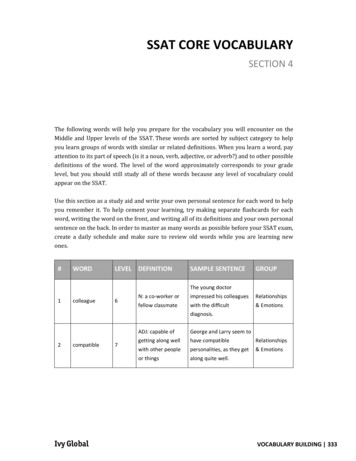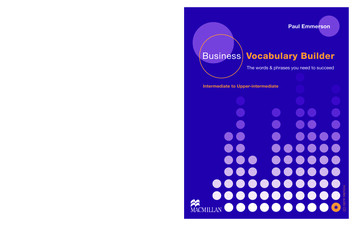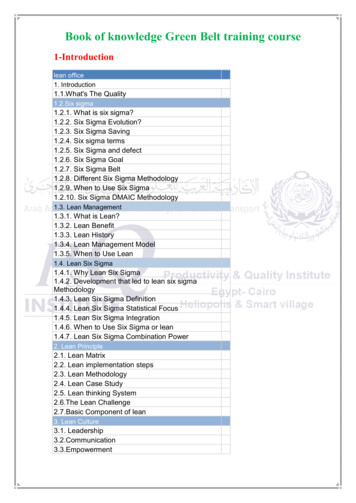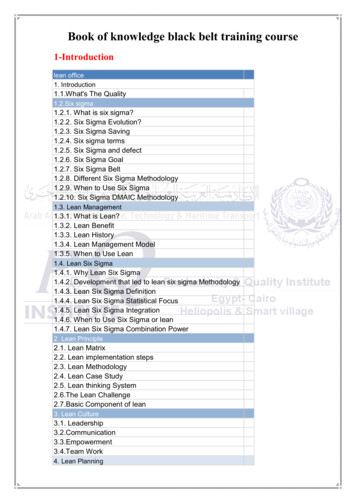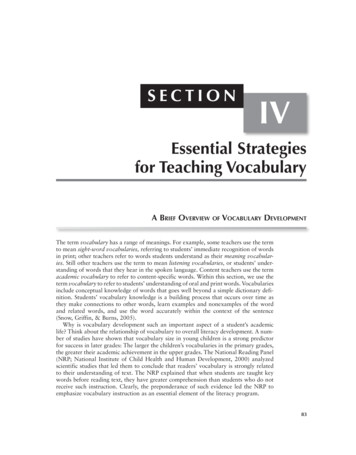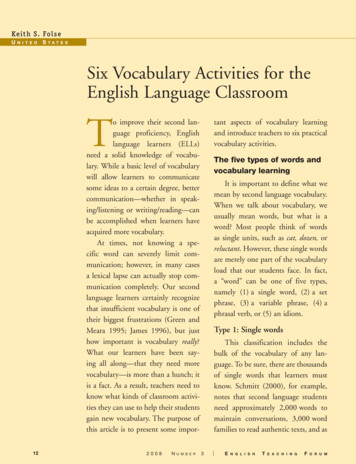
Transcription
Ke i t h S. Fo l s e —Six Vocabulary Activities for theEnglish Language Classroom—To improve their second language proficiency, Englishlanguage learners (ELLs)need a solid knowledge of vocabulary. While a basic level of vocabularywill allow learners to communicatesome ideas to a certain degree, bettercommunication—whether in speaking/listening or writing/reading—canbe accomplished when learners haveacquired more vocabulary.At times, not knowing a specific word can severely limit communication; however, in many casesa lexical lapse can actually stop communication completely. Our secondlanguage learners certainly recognizethat insufficient vocabulary is one oftheir biggest frustrations (Green andMeara 1995; James 1996), but justhow important is vocabulary really?What our learners have been saying all along—that they need morevocabulary—is more than a hunch; itis a fact. As a result, teachers need toknow what kinds of classroom activities they can use to help their studentsgain new vocabulary. The purpose ofthis article is to present some impor122008Nu m b e rtant aspects of vocabulary learningand introduce teachers to six practicalvocabulary activities.The five types of words andvocabulary learning—It is important to define what wemean by second language vocabulary.When we talk about vocabulary, weusually mean words, but what is aword? Most people think of wordsas single units, such as cat, dozen, orreluctant. However, these single wordsare merely one part of the vocabularyload that our students face. In fact,a “word” can be one of five types,namely (1) a single word, (2) a setphrase, (3) a variable phrase, (4) aphrasal verb, or (5) an idiom.Type 1: Single words—This classification includes thebulk of the vocabulary of any language. To be sure, there are thousandsof single words that learners mustknow. Schmitt (2000), for example,notes that second language studentsneed approximately 2,000 words tomaintain conversations, 3,000 wordfamilies to read authentic texts, and as3 En g l i s hTE a c h i n gFo r u m
Because of their quantity and frequency,phrasal verbs are an especially difficult vocabulary item for ELLs. In particular, phrasalverbs are extremely common in everyday conversation. More problematic is the fact thateach phrasal verb can also be polysemous, thatis, each one can have multiple, very differentmeanings.How problematic is the polysemy of phrasal verbs? A good example is the base verb take,which, as was shown above, can combinewith all nine particles to produce nine newphrasal verbs. However, each of these newnine phrasal verbs is in turn polysemous. Forexample, consider some different meaningsof take off: remove clothing (“He took off hissweater.”) succeed (“His career took off.”) gain altitude (“The jet took off.”) leave (“I’m going to take off.”)many as 10,000 words to comprehend challenging academic texts. Single words are thelargest type of words and are used more frequently than other words.By single words, we mean not only a wordlike room but also bedroom and living room. Allthree of these examples are considered singlewords even though living room requires twotraditional words, that is, two collections ofletters, to express its concept, while bedroomrequires only one. (The actual number of traditional words in a vocabulary item reflects spelling conventions in English, not vocabulary.)Type 2: Set phrases—Set phrases consist of more than one wordand do not vary. For example, in the set phraseon the other hand, we cannot say in the otherhand, or in other hands, or in other fingers,even though these options are semanticallyrelated.Common set phrases include now andthen (not then and now), the bottom line (notthe lowest line), ladies and gentlemen (notgentlemen and ladies), and all of a sudden (notsome of a sudden or none of a sudden).Likewise, take up has at least three distinctmeanings: collect (“I’m going to take up the examnow.”) occupy space (“The table takes up halfthe room.”) begin a new hobby or pastime “(I tookup tennis when I was fifteen.”)Type 3: Variable phrases—While most of the components in variablephrases will stay the same, there is some variation, often with personal pronouns, possessiveadjectives, or word order. For example, in thevariable phrase It has come to our attentionthat, we can change the possessive adjectiveour to my. Likewise, the phrase off and on canalso be on and off. Thus, if it has been rainingintermittently, we can hear “it’s been rainingoff and on” as well as “it’s been raining onand off.”Thus, take, which forms part of at leastnine phrasal verbs, has more than nine meanings, perhaps in fact as many as thirty.Type 5: Idioms—All languages feature idiomatic expressions, and each idiomatic expression, oridiom, is a separate vocabulary item. A groupof words is an idiom if the meanings ofthe individual words are different from themeaning of the whole phrase. For example,when a person lets the cat out of the bag, itmeans that the person has revealed a secret.There is no cat, there is no bag, and there isno cat in any bag. The words let, cat, out, andbag are all high frequency words, ones thatmight be covered in any basic or even beginning level English class. However, knowingthe meaning of these four words does notprepare the learner to figure out the meaningof the idiom.Furthermore, this idiom is a set phrase. Ifthe secret is extremely important, we cannotType 4: Phrasal verbs—A phrasal verb consists of two or threewords with the first word being a verb andthe second (and third) word a particle. Manyverbs can serve as the verb in a phrasal verb,but common verbs here include put, take,come, call, make, go, and get. These base verbsare often mixed with nine different particles—up, down, on, off, in, out, away, back, andover—to form unique words. For example,the base verb take with these nine particlesproduces these nine phrasal verbs: take up,take down, take on, take off, take in, take out,take away, take back, and take over.En g l i s hTE a c h i n gFo r u m Number3200813
names the item without assigning a value.Negative and positive words have a valueassigned to the word. Thus, dog is neutral,mutt is negative, and purebred is positive.Likewise, child is neutral, kid can be negative,and youngster is positive.Connotation affects usage. For example, agiven word may be appropriate for a formaltalk but sound stilted in everyday conversation. Two or more words may mean more orless the same thing, but they have differentconnotations and therefore different usages.For example, sweat and perspire refer to thesame bodily function. However, we rarely saythat athletes perspire, and deodorant containers never feature the word sweat. Instead, wesay that athletes sweat but deodorants helpcontrol perspiration.As another example, let us consider theconcept of “not continue to live.” The basicvocabulary item to express this concept is theword die, but we could also use the words passaway or kick the bucket. While we can say “I’msorry to hear that your uncle died,” it mightbe more common, especially when talkingwith a known person and wishing to conveyour sympathy, to say “I’m sorry to hear thatyour uncle passed away.” The usage of passaway is restricted to a speaker who knowsthe listener and who wishes to express sincereregret or sympathy. That same person wouldnever say, “I’m sorry to hear that your unclekicked the bucket.”say let the lion out of the bag, nor can we say letthe kitten out of the bag for a relatively unimportant secret. In addition, we would neversay let the cat out of the sack, even though sackcan be a synonym for bag.Most phrasal verbs are idiomatic. Forexample, the phrasal verb throw up, whichmeans “to vomit,” is not the simple sum of themeanings of throw and up. Likewise, learnersare rightly justified in being confused whenthey find out that the opposite of put on clothing is not put off clothing. If the airplane takesoff at the beginning of a flight, why doesn’t theplane take on at the end? With idioms, logicoften has no place.Additional aspects of vocabularyknowledge—In theory, mastering vocabulary should notbe so different from learning any other component of a language, such as grammar, spelling, or pronunciation. Vocabulary, however, isa special problem because there are multipleaspects of vocabulary knowledge that learnersmust master, including polysemy, connotation and usage, part of speech, frequency, andcollocation.Polysemy—One of the biggest challenges for ELLswhen learning vocabulary is that mostwords—whether single words, set phrases, variable phrases, phrasal verbs, or idioms—often have multiple meanings. Thispolysemy is a real problem for ELLS. Somewords have just a few meanings. The wordhammer, for example, can be the instrument(noun) or the action (verb). Many words,however, have a large number of meanings.For instance, the word table can be a pieceof furniture, a set of numbers or figures, theaction of ceasing discussion about somethingin a meeting, or a descriptive word (as intable scraps or tablecloth). As discussed earlier,a phrasal verb such as take up can be polysemous, as in these examples: take up the testpapers, take up too much space, or take up anew hobby.Part of speech—The part of speech of an unknown wordcan present problems. To use a word correctly in a sentence, ELLs must know thedifference between four basic parts of speech:noun (amazement), verb (to amaze), adjective (amazing), and adverb (amazingly). Inlearning new words, nouns are probably theeasiest part of speech to learn, followed byverbs, adjectives, and adverbs (Ellis and Beaton 1993; Atkinson 1975). Among nouns,Mackey (1965) notes that frequent, concretenouns are easier to learn than less frequent,abstract nouns but cautions that even frequent, concrete nouns can be a problembecause they may contain other factors ofdifficulty, such as polysemy.Some teachers may assume that knowingone part of speech of a word allows studentsto learn all four basic parts of speech ofConnotation and usage—The connotation of a word is its value, thatis, the way native speakers view that particularword. Connotations of words can be neutral,negative, or positive. A neutral word simply142008Number3 En g l i s hTE a c h i n gFo r u m
that word. However, in a study of nonnative-English-speaking university students,Schmitt and Zimmerman (2002) foundthat few students know all four forms ofa word. In other words, partial knowledgeof at least one form was the norm. Resultsalso showed that learners tended to have abetter understanding of the noun or verbforms rather than the adjective or adverbforms. The authors conclude that teacherscannot assume that learners will absorbthe derivative forms of a word family automatically from exposure and suggest explicitinstruction in this area of vocabulary, thatis, morphology.Let us consider the verb squander, whichmeans “to waste” or “use unwisely.” Squanderis a transitive verb; thus, any noun in theorycould follow this verb. Studies of an actuallanguage sample, or corpus, are useful inrevealing the most common collocations forwords (Nation 2001). For example, the mostcommon collocations for squander are moneyor resources (salary, 1,000, inheritance), time(the morning, her vacation, a lifetime), oropportunity (chance or prospect). Thus, common collocations for the verb squander aremoney, time, and opportunity.Another good example of collocationoccurs with the verb commit. The basicmeaning of commit is “to make” or “to do.”Corpus studies reveal that the most commoncollocations for commit as a verb are types ofcrimes: commit murder, commit suicide, commit grand larceny, and commit fraud. Thus,commit does not mean just “to make or do”but “to make or do something negative.”An ELL who learns that commit in commit amurder means “to do or perform an action”might attempt to make the following seemingly logical combinations: commit a joke onsomeone, commit the housework, or commita meal. The problem—a huge problem forELLs—is that commit does not collocatewith joke, housework, or meal. Because ofboth the difficulty and the importance ofcollocations, McCarthy (1984) advocatesdirect instruction and practice in this area.Frequency—Knowing a word can also mean that thelearner knows the frequency of occurrence ofthat word. Though this aspect of a word mayseem trivial, the frequency of a word is oftencited as a major factor in a given word’s difficulty. In fact, Brown (1993) claims that wordfrequency is probably the major componentin word difficulty.A given word may well express the concept that the person wants to express; however, that concept may have several possiblenames, some of which may be more usefulto a nonnative learner because that particular word is more frequent. The rarerforms, though most certainly semanticallyappropriate, would make the speaker soundstrange. For example, usual and common canbe synonyms, but we say that “Smith” and“Thompson” are common last names, notusual last names. While discard and throwaway are synonyms, it would be unnaturalfor a native speaker to say to a good friend,“I’m going to discard these books.”Important goals in selecting vocabularyactivities—In this section, I draw on the secondlanguage vocabulary research explaining theneed for learning tasks that emphasize language output (Swain 1993). The most successful vocabulary activities are those thatallow students to accomplish three goals:(1) focus on the vocabulary, (2) experiencemultiple retrievals of the vocabulary, and(3) develop successful vocabulary learningstrategies.Collocation—Perhaps the single most important aspectof knowing a word for nonnative learners—besides the obvious synonyms forthe word—is the collocation(s) of a newvocabulary item. Collocation (co- meaning“together” location) is a word or phrase thatnaturally and frequently occurs before, after,or very near a particular vocabulary item.The challenge here for ELLs is not learning the word’s meaning (or other previouslyexplained factors) but rather learning whichwords are actually used with this word.En g l i s hTE a c h i n gFo r u mGoal 1: Focus on the vocabulary—Students learn second language vocabulary better when they “notice,” or focus theirattention on, the vocabulary (Schmidt 1990).If students read a passage in which a certainunknown word is present but not essentialto understanding the passage, students are Number3200815
Goal 3: Develop successful vocabulary learning strategies—less likely to notice the word, which meansthey are less likely to learn the word (Laufer1997). Comprehensible input alone is notsufficient for the large number of vocabularyitems that learners must master to improvetheir language ability. The input needs to benoticed so that it can become intake (Swain1993).To make sure that students notice newwords, teachers can write them on the boardfor all to see. They can also keep a separatesection of the board for vocabulary, or inclassrooms where this is not possible, post alarge sheet of paper or newsprint on the wallwhere new words are written. It is not a goodidea to write down every new word; instead,teachers should write down words that theythink are useful to their students. Teachersshould focus on words that are relevant totheir students’ actual language needs, whichmay include actual communication or passing a standardized examination. Any teacher’sgoal is to select words that match students’real-world needs.Focus can also be achieved by having ELLsmark key vocabulary in some way. Nowadaysmany textbooks have key vocabulary underlined or in boldface. However, if your textbookdoes not identify key v ocabulary in some veryvisible way, then have your students underlineor circle words that you indicate are importantto know.Teachers would like a list of three or foursolid vocabulary learning strategies that workwell for all students, but such a list does notexist (Folse 2004). Sanaoui (1995) found thatthe best vocabulary learners do not use a limited set of strategies; instead, she found thatthe best learners have a selected set of strategies that they use consistently. Thus, teachersneed to acquaint students with a variety ofstrategies and encourage them to discover thestrategies that they prefer. Teachers shouldcontinue to monitor students to help thembecome aware of their strategy use. In otherwords, teachers must train learners to developtheir own set of strategies and employ themconsistently. Schmitt and Schmitt (1993)provide a comprehensive listing of strategiesfor keeping a vocabulary list, using the wordin a speaking task, or illustrating the word insome way.Six vocabulary activities for the ESL/EFLclassroom—Results from research on second languagevocabulary clearly call for more vocabularypractice in classes, especially classroom activities that include the three goals of focusing,multiple retrievals, and developing successfullearning strategies. In this section, I explainsix activities that help learners focus theirattention on the vocabulary, require learnersto retrieve the forms and meanings of the newwords, and encourage learners to identify anddevelop a personalized repertoire of specificpreferred strategies for vocabulary learning.These six activities have been used successfullyin several EFL settings with learners rangingfrom teenagers to adults.Goal 2: Experience multiple retrievals ofvocabulary—Perhaps the single most important component in learning vocabulary efficiently is ahigh number of retrievals of the word (Folse2006a). What does this mean? The simpleanswer is that learners must interact with aword multiple times. Rather than completing just one type of learning task multipletimes, such as repeating a word, learnersshould interact with a word in differentways. These ways of retrieving a word couldinclude matching words with definitions,asking themselves the meaning of a word,pronouncing a word, naming a word that isconnected in some way (e.g., match cook orfood with bake), or even simply spelling theword. Each link strengthens connections andincreases learning success (Atkins and Baddeley 1998).162008NumberActivity 1: Keeping a running list of words—Students remember a certain percentage ofwhat they see and a certain amount of whatthey hear, but they will remember even moreof what they see and hear. Therefore, youshould make a list of vocabulary as you areteaching. Point out the words to focus learners’attention on the words. In addition to providing focus and multiple retrievals, writing a listalso shows the students an example of keeping a vocabulary notebook, which is one ofmany good vocabulary learning strategies. It3 En g l i s hTE a c h i n gFo r u m
is important for ELLs to see a model of whattheir notebooks could look like (Folse 2004).Keeping a vocabulary list on the board isa good first step, but students are bombardedby all sorts of information all day long. Yourjob is to make these words memorable, andone way to do this is by doing somethingunique with the words as you teach them.These unique actions could include drawingthe word, making a story about it, or evenspelling it backwards. More common actionscould include pronouncing the word, notingits antonym, or asking if anyone knows theword already. Let us look at teaching optionswhen noting the two following words on ourvocabulary list: valley and the bottom line.When teaching the word valley, you couldask students what the shape of a valley is.They will indicate that a valley is shaped likethe letter V. Thus, you might write the wordwith an extra big initial letter to indicate thisrelationship: Valley.The idiom the bottom line is a good wordto illustrate. Have students draw several lines,one on top of the other. The lowest lineshould be bigger or thicker than the otherlines to indicate that it is more important thanthe other lines. Have your students draw anarrow to the lowest one and then label it “thebottom line.” Thus, learners have illustratedthat the bottom line means the most important point or factor in a discussion.True or False Exercise—A valley is a kind of animal.True[Answer: False]Error Identification Exercise—All of the valley in that region are whitein winter and green in spring.Which underlined word, if any, is inerror?[Answer: The word valley should bevalleys.]Each card contains only one exercise. Writethe questions in large enough print or font sothat students can see the cards as they work inpairs or small groups of three or four students.This activity can and should be repeated, evenwith the same cards, because students willmost likely be working with different classmates. This second or third practice with thesame cards (but with different students) allowsfor multiple retrievals. It also allows studentsan opportunity to share their strategies forhow they remember certain vocabulary. Besure to allow enough time in between uses sothat students do not remember the cards.Activity 2: Vocabulary cards—Activity 3: Ranking vocabulary items—A very simple yet effective practice activityuses vocabulary cards that contain one question each. The teacher puts students in pairsor small groups, and their task is to discussand solve the vocabulary question presentedon the card. These teacher-generated cardscan feature a variety of exercises, as seen in thefollowing examples for the word valley:In a ranking activity, you present the classwith a list of six to eight items that they mustrank according to some factor. For example,you could present cities that students mustrank according to population, or historicalevents that students must rank accordingto importance. Choose a list of items thatrepresent a theme that is meaningful to yourstudents. Embed key target vocabulary in theactivity, and put these target words in bold orunderline them.The following ranking activity practicesquantity words in English, particularly different kinds of containers. First, have studentswrite their own rankings by themselves. Thenhave students work in groups of three or fourto discuss their rankings and then reach agroup consensus on one ranking list for theirgroup.Multiple Choice Exercise—The area between two mountains iscalled a .A. voucher—B. valley—C. wound—D. wave—[Answer: B.]En g l i s hTE a c h i n gFo r u mFalse Number3200817
To create the puzzle, replace all of the letters with dashes to indicate how many lettersare in each word. Each series of dashes are followed with a clue, as in the example below.Ranking Activity—Directions: The following six items werebought at (fill in the name of a local storethat all of your students know) yesterday.Use your knowledge of prices to rankthese from the cheapest (1) to the mostexpensive (6).a bag of chipsa can of tunaa box of cereala bunch of bananasa carton of eggsa pack of gum—Vocabulary Ladder PuzzleDirections: The five missing words in thevocabulary ladder all have three letters.Each word differs from the word immediately above or immediately below byonly one letter. Use this information andthe clues to solve the puzzle.If you do this as a speaking activity,remember that there are actually two typesof language needed for this activity (Folse2006b). The language that is in the task is notusually the same language that learners needfor the subsequent speaking task. Most teachers are good at identifying the language in thetask. Here this includes container words suchas bag or box and food names such as cereal oreggs. However, teachers should also considerthe language that students need for the speaking task. Students will need such language as“What did you rank number 1?” or “No, Ithink that a box of cereal is more expensivethan a carton of eggs.”When I was shaving thismorning, I myself.3.Would you like a ofcoffee?4.A baby dog is called apuppy or a .5.Let’s some popcorn!I’m hungry!This activity works well for the wholeclass. In brief, you will auction sentences usingpreviously studied vocabulary, and the students’ goal is to buy as many correct sentencesas possible in the auction. For this activity,you will need paper money and a list withsentences to auction.The sentences can range from simpleto complex depending on the level of yourstudents, with key target vocabulary in capital letters, in boldface, or underlined. Thesesentences can be written on paper with onesheet given to each group of students, or thesentences could be written on a transparencyand viewed on the board. Notice how the foursentences in the example work on a variety oflevels of knowledge ranging from basic meanings to actual usage.cat—cut—cup—pup—pop—These five words are the answers for this wordladder puzzle (Folse, 1993, 113).Number2.Activity 5: Vocabulary sentence auctionIn this task, the teacher will construct aladder of five words that all have the samenumber of letters. Within the ladder of fivewords, each word differs from the wordimmediately above or immediately below byonly one letter, for example:—2008My first pet was a .If students do not know one word, theyshould skip that clue and go to the wordsabove and below the unknown word. Oncethey have the answers above and below theword, they can rearrange the letters to discoverthe missing word. In doing this activity, learners frequently talk about a word several times,thus producing multiple encounters with theword.Activity 4: Vocabulary ladder puzzle181.3 En g l i s hTE a c h i n gFo r u m
Example: 12 Vocabulary Pieces forEnvelope #1—Example: Vocabulary Sentence Auction—1. An ITEM is a kind of rock.(definition/synonym)—during the review / SESSION yesterday,/ the teacher CALLED / ON thesleeping student—2. HOWEVER means sin embargo.(translation for Spanish speakers)—he LET / THE CAT / OUT OF THEBAG / and ruined the SURPRISE /PARTY—3. CLUMSY has a negative meaning.(basic meaning of word)—people who / COMMIT / A CRIMEoften / END UP / in jail—4. He drank two BEETS before dinner.(sentence with usage)—[Answer: “During the review session yesterday, the teacher called on the sleepingstudent. He let the cat out of the bag andruined the surprise party. People whocommit a crime often end up in jail.”][Answers: 1. incorrect, 2. correct,3. correct, 4. incorrect]—Give students a few minutes to study thelist and decide the best items to bid on. It isimportant to explain before and during theauction that there is no penalty for buyingwrong vocabulary sentences and that there isno credit for leftover money.The teacher starts the auction by asking forbids for item number 1. When the biddingappears to be nearing an end, announce, “OK,this group (point to group or say the student’sname) has bid (whatever the amount is). Arethere any other bids?” If there are no otherbids, slowly say “Going . going . Gone Sold to (the group).” Give that group a pieceof paper or a card with the sentence numberon it, or write that information on the board.At the end of the auction, announce whichsentences are correct. The winner is the groupthat has purchased the highest number ofcorrect items.For a class of fifteen who are working infive groups of three, you will need approximately eight to ten envelopes. For a largerclass, you will need to prepare a proportionatenumber of additional envelopes.List the teams on the board in a grid withthe envelope numbers at the top of the grid.Pass out the envelopes. Ask each team to firstempty the contents of the envelope on theirdesk and verify that they have all the pieces.Then students try to reassemble the sentences.When they are finished, the teacher goes overto verify the sentences. The teacher only says“yes” or “no.” If yes, then that team puts allthe pieces back in the envelope, gets a checkmark on the board for that envelope number,and then takes another envelope. The winneris the team that completes the most envelopesin a given time period (set by the teacherbeforehand).Activity 6: Scrambled vocabulary envelopes—This activity provides practice with collocations. In this activity, students work ingroups of three or four to rearrange sentenceparts into correct sentences.Prepare a set of sentences that illustratepreviously studied vocabulary in capital letters.Cut each sentence into pieces and put thesepieces into an envelope. (For example, a sentence might be cut into three to five pieces.)Label this envelope as #1 and write the number of pieces on the outside of the envelope:“Envelope #1, 12 pieces.” This informationdoes not indicate the number of sentences inthe envelope. In the example below, the slashmarks indicate possible places to cut the sentences. Notice that I have not used a capitalletter for the first word or final punctuation.En g l i s hTE a c h i n gFo r u mConclusion—English language learners need to increasetheir vocabulary knowledge. Given the timeconstraints of many learners, teachers shouldincorporate explicit vocabulary teaching supported by classroom activities that reinforcepreviously studied material. Such activitieswill help learners focus their attention on keyvocabulary, require learners to retrieve theforms and meanings of the new words, andencourage learners to identify and developa personalized inventory of strategies forvocabulary learning. Our ultimate goal is tohelp our students be active vocabulary learners after they leave our classrooms. Number3200819
Note: For handouts on teaching vocabulary,see: www.keithfolse.com/handouts.htmlMcCarthy, M. 1984. A new look at vocabulary inEFL. Applied Linguistics 5 (1): 12–22.Mackey, W. 1965. Language teaching analysis. London: Longman.Nation, I. S. P. 2001. Learning vocabulary in anotherlanguage. Cambridge: Cambridge UniversityPress.Sanaoui, R. 1995. Adult learners’ approaches tolearning vocabulary in second languages. Modern Language Journal 79 (1): 15–28.Schmidt, R. 1990. The role of consciousness insecond language learning. Applied Linguistics 11(2): 129–58.Schmitt, N. 2000. Vocabulary in language teaching.Cambridge: Cambridge University Press.Schmitt, N., and D. Schmitt. 1993. Identifying andassess
portant secret. In addition, we would never say . let the cat out of the sack, even though sack can be a synonym for . bag. Most phrasal verbs are idiomatic. For example, the phrasal verb . throw up, which means "to vomit," is not the simple sum of the meanings of . throw. and . up. Likewise, learners are rightly justified in being confused .

